XEROCHRYSUM
Xerochrysum
Tzvelev, Novosti Sist. Vyssh. Rast. 27: 151. 1990; Chen & Bayer, Fl. China @ eFloras.org 20-21: 6, 774, 817; Nesom, Fl. North Amer. @ eFloras.org 19- 21: 427.
Annual, biennial or perennials, 20-90+ cm. Stems usually 1, erect, branched, usually arachnose and +/- stipitate-glandular. Leaves cauline, alternate, sessile, blades elliptic to spatulate to oblanceolate, lanceolate or linear, surfaces concolorous, usually arachnose and +/- stipitate- glandular, margin generally flat and, entire. Capitula disciform, heterogamous, borne singly or 2-3 in loose corymbose arrays. Involucres +/- hemispheric, 10-30 mm. Phyllaries in 3-8+ series, yellow, brown to purple, white, pinkish, unequal, entire, papery, monomorphic, monochromous, usually chartaceous towards tips, spreading in flowering, deflexed in age. Receptacle flat, glabrous, epaleate. Peripheral florets: Pistillate, (0-) 25-50 (fewer than bisexual florets), filiform, corolla yellow. Inner florets: Bisexual, 200-400, corolla yellow, lobes erect, veins ending before apex of lobes. Anthers ecalcarate or sharply tailed, appendages concave, as wide as thecae; style bifid, style branches acute with obtuse sweeping hairs dorsally, stigmatic surfaces separated. Cypselae columnar to +/- prismatic (4-angled), faces smooth, glabrous. Pappi 25-35+, in 1 series, free or loosely basally +/- coherent, subplumose to barbellate bristles, falling readily separately or in groups or ring. Cypselae and pappus similar in both types of florets.
25 species
Xerochrysum bracteatum
Xerochrysum bracteatum
(Vent.) Tzvelev, Novosti Sist. Vyssh. Rast. 27: 151. 1990; Fl. China @ eFloras.org 20-21: 817; Fl. North Amer. @ eFloras.org 19-21: 426, 428; Brown, New South Wales Flora online; Xeranthemum bracteatum Vent., Jard. Malmaison 1: plate 2. 1803; Bracteantha bracteata (Vent.) Ander. & Haegi, Opera Bot. 104: 105. 1991; Helichrysum bracteatum Andrews, in Bot. Repos. 6: t. 428.1805.
Erect, usually annual herbs, 30-80 cm high, simple or rarely branched at base. Stems +/- scrabous hairy and minutely glandular hairy. Leaves alternate, sessile, 1.5-10 cm x 0.5-2 cm, narrow elliptic to lanceolate, concolorous, scabrous-pubescent, especially on margins, costa prominent, base gradually narrower, margin entire, apex acute. Capitula disciform, terminal on all branchlets, forming irregular leafy inflorescences, usually on peduncles to 15 cm long; capitula 1-2 cm long and 3-5 cm across (across open involucres). Receptacle flat, glabrous and epaleate, all florets discoid. Involucres hemispheric. Phyllaries (involucral bracts) curl over and enclose the florets, shielding them before anthesis. Phyllaries in many series, imbricate, petal-like (or ray florets-like), stiff, papery, white to pink, yellow, red and purple, lamina oblique to spreading and finally reflexed, unequal, outer and inner small, 5-6 mm x 4-5 mm, intermediate phyllaries largest, 10-15 mm x 6- 8 mm. Receptacle flat, epaleate, glabrous. Disc florets: Numerous, ca. 10 mm long, peripheral female and inner bisexual. Corolla yellow, tubular, ca. 9 mm long, bent at the junction of tube and throat; tube nearly equal or shorter than tubular-funnelform throat, lobes 5, erect, small, 0.5 mm long, triangular. Anthers exserted, ca. 3 mm long, shortly tailed or ecalcarate, appendages concave and as wide as thecae. Cypselae columnar, 4-angled, 2-2.5 mm x 0.6-0.7 mm, dark brown, surfaces smooth, glabrous. Pappus of many golden or white bristles, ca. 8 mm long, nearly equal to corolla, connate at base; subplumose at base, barbellate in upper 2/3rd with a few longer barbs at apex.
Common Names: Golden Everlasting, Strawflower, Paper Daisy, Paper Flower
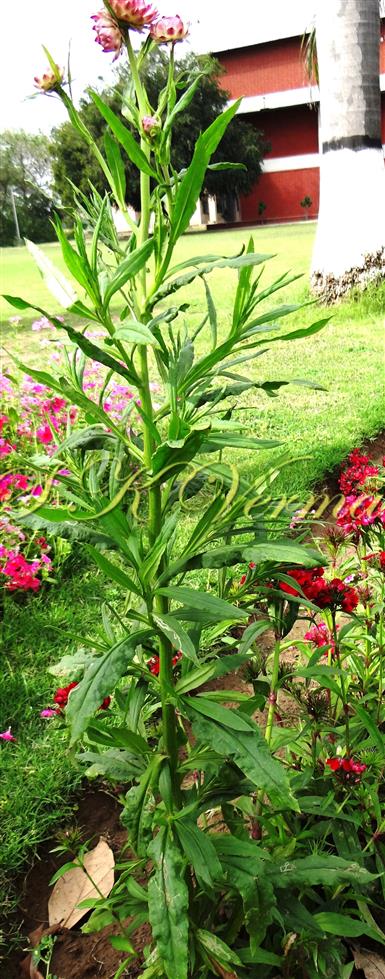
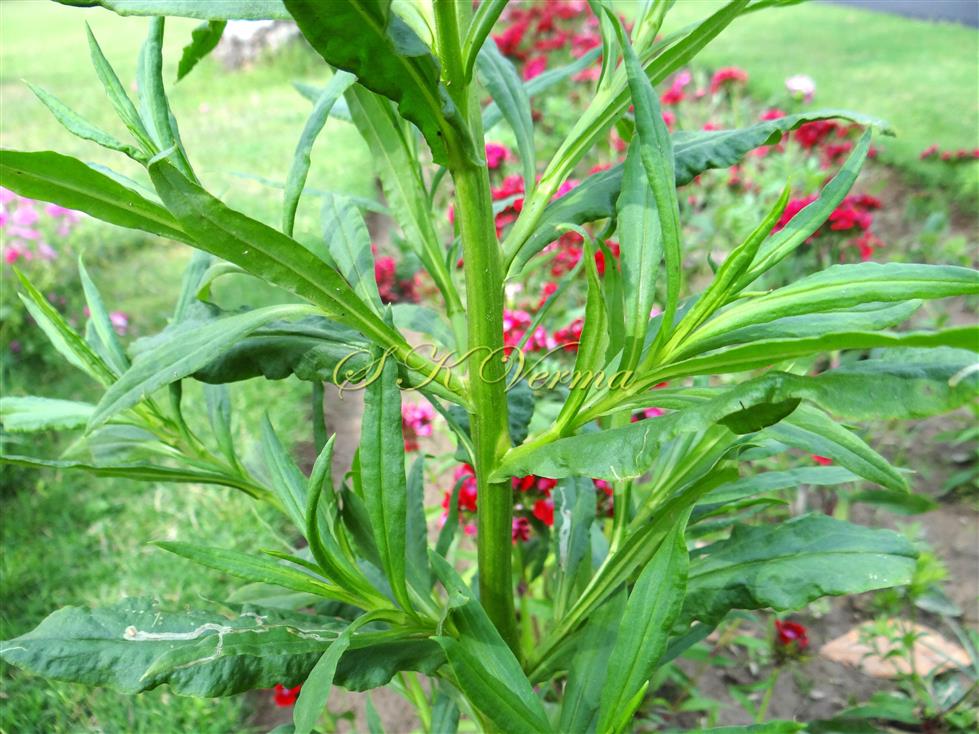


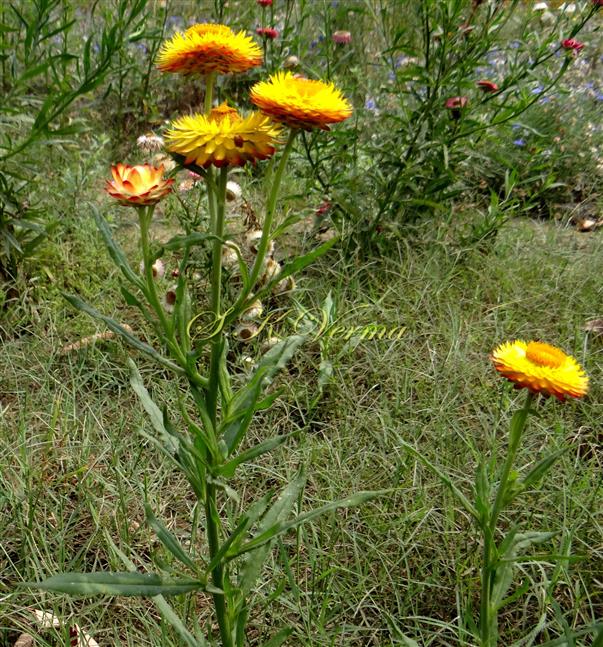
-DSC04670.jpg)
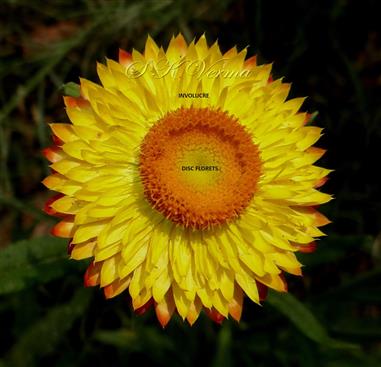
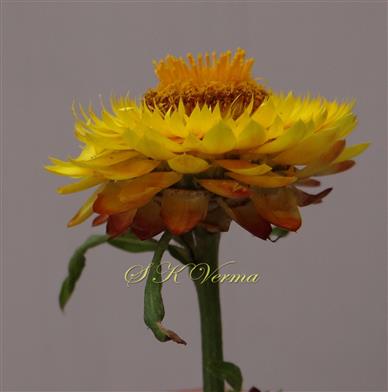
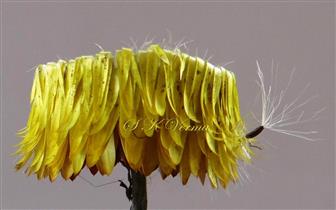
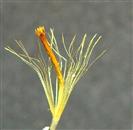
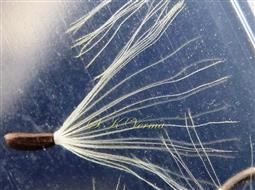
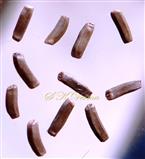






-DSC04670.jpg)





